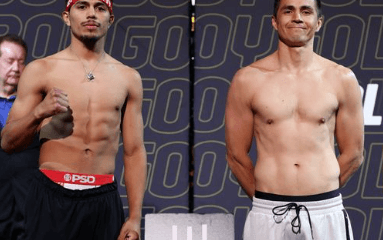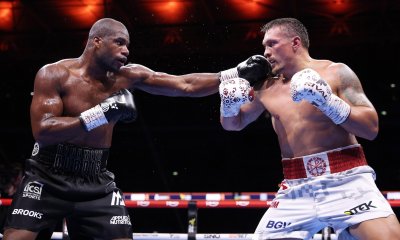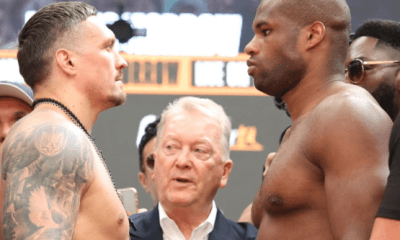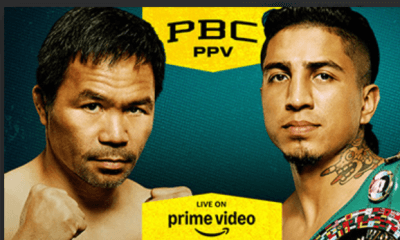Asia & Oceania
Southern California: The Soul of Boxing Part 3
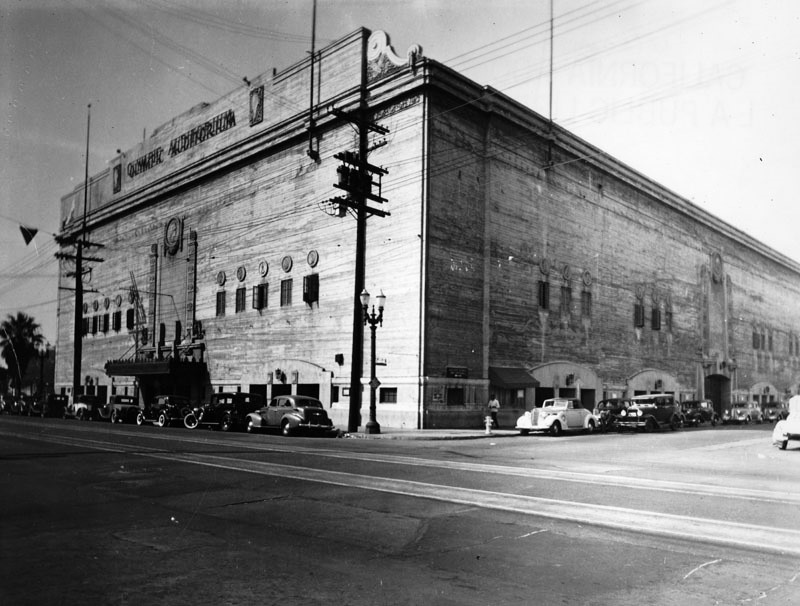
It was the biggest Los Angeles fight in decades when Oscar “The Golden Boy” De La Hoya agreed to meet Sugar Shane Mosley for not only the WBC welterweight world title but for status as the best fighter pound for pound.
Both prizefighters had been born and raised in the city of Angels and had been rivals throughout their amateur boxing years. Their two roads converged at the sparkling new Staples Center on June 17, 2000. It was like a movie premiere but for boxing.
Not since Danny “Little Red” Lopez met Bobby “Schoolboy” Chacon in 1974 at the L.A. Memorial Sports Arena down on Figueroa Street had Los Angeles staged a similar fight between hometown rivals. But the magnitude of this fight was tenfold.
Shiny limousines arrived with diamond studded movie stars emerging one after another. Most of Hollywood showed up as if it were the Academy Awards. From Halle Berry to Ryan O’Neal, the number of celebrities that arrived to see the fight was off the charts as fans cheered the arrivals.
But the biggest roar from fans occurred when Muhammad Ali appeared out of one of the tunnels and walked toward the seats along the boxing ring. Nothing else could compete with the great heavyweight’s appearance.
That night De La Hoya and Mosley erupted into an electric performance with each round topping the next. Their fight set the benchmark for all other prize fights in the future for L.A.
Mosley beat De La Hoya that night. Soon after, the East L.A. boxer decided to form his own boxing promotion company. In 2002, the deal was done and slowly his company Golden Boy Promotions became a major player in a sport that gobbles up promoters like sunflower seeds.
The world title fight between De La Hoya and Mosley snapped the hold that Las Vegas had held over major fights for the past 20 years. The casino capital had staged some of the biggest prize fights in history beginning with Larry Holmes-Muhammad Ali in 1980, Ray Leonard-Tommy Hearns in 1981, to Lennox Lewis-Evander Holyfield in 1999.
When De La Hoya and Mosley fought before more than 18,000 fans it smashed the myth that boxing was dead in Los Angeles. Or did it?
Newspaper Coverage
The arrival of the Los Angeles Dodgers in 1958 and subsequent World Series win in 1959 did not put a hurt on boxing. The Los Angeles Lakers arrived in 1960 and the L.A. Rams had arrived in 1946 but football never took away coverage from boxing by local newspapers. The sport of boxing survived.
Perhaps the most telling blow came when the weekly boxing shows provided at the Olympic Auditorium shut down. Aileen Eaton was the promoter and her run of successful shows at the boxing palace was unrivaled in Los Angeles. But when she passed away in 1987 it basically snapped the run of weekly shows that kept boxing in the news.
“She was the smartest person I ever met,” said Don Chargin, the matchmaker for many of the fight cards at the Olympic Auditorium (pictured). “She was a smart businesswoman who had what was needed to put on successful shows.”
Eaton demanded newspaper coverage and got it.
From 1942 to 1987 the Olympic Auditorium was California’s hot spot for live boxing shows. Eaton had taken over as the promoter when her husband Cal Eaton died in 1966 and created weekly boxing cards that brought crowds in droves for decades. Stars like Manuel Ortiz who held the bantamweight world title for eight years and is considered perhaps the greatest 118-pounder of all time. Or, others like Mando Ramos and Art Aragon, “The Golden Boy.” Though Aragon never won a world title, his antics and personality attracted thousands to the Olympic Auditorium or wherever he fought.
Most of these boxers trained at the Main Street Gym which one accessed by walking ip a flight of stairs. On the right side would be wooden benches where visitors could sit and watch for a fee, originally 10 cents. When Howie Steindler was in charge he was adamant about collecting that fee.
Inside the Main Street Gym was a set of desks for boxing beat reporters who would regularly visit the gym. They were as visible as the trainers and knew every fighter, good or bad, inside the gym. A set of phones was nearby for the journalists to contact their sports desks.
“You wouldn’t see the reporters every day but they would come enough that you knew who they were,” said Benny Georgino whose fighters Alberto Davila, Danny “Little Red” Lopez and Jaime Garza trained in the second floor gym in Los Angeles. “You knew these guys. They would call you all the time or watch sparring to see how somebody was doing before a big fight. The L.A. Times or the guys from the Herald-Examiner knew everybody at Main Street or at Hoover Street Gym. You don’t get that today from the newspaper guys.”
Even newspaper boys hawking on street corners were familiar with the boxing game. One former newsboy remembers seeing many famous boxers enter and exit from one of the earliest versions of the downtown L.A. boxing gym. Two other gyms preceded the final one that was on Main Street. The others were on Spring Street and another on Main Street but a few blocks south.
“I remember seeing Tiger Flowers get out of a car telling everybody he was a world champion,” said Leonard Castillon, who was a newsboy during the 1920s near the gym located on Spring Street. “People were cheering and shaking his hand. I didn’t know who he was. I just remember the name.”
Flowers had beaten the great Harry Greb twice for the middleweight world championship in 1926. Greb died in 1926 and Flowers died in 1927. Both passed away from complications during surgery.
Boxing was always in the news.
Sporadic Coverage
Today there is beat coverage by newspapers for NBA, MLB, NHL , and NFL with daily reports regardless if local teams are playing significant games or not. Boxing only gets coverage when a major prize fight is being televised on a cable network like HBO, Showtime or ESPN. Otherwise, all other fight cards are ignored.
Recently within the past five years a newspaper group bought 12 newspapers in Southern California. The result has been one boxing reporter represents the newspaper chain and if that reporter does not reveal or talk about a fight card, then readers for those dozen newspapers have no idea boxing is taking place. The same goes for the L.A. Times that also owns the leading San Diego newspaper. If that newspaper does not mention a boxing card, then its readers are not aware of its existence.
Forget about television news, they get their news from the newspapers.
During the last three years downtown L.A. saw regular boxing cards take place in the downtown L.A. area but seldom did major news groups mention it. Could it be pure ignorance or a subtle cultural slight?
As most observers know, boxing in the US is dominated by Latinos and African Americans. In Europe boxing has strong news coverage and that’s also true of Japan and the Philippines. Only in America does news coverage barely exist.
MMA
The emergence of MMA saw immediate interest by local newspapers especially when Ultimate Fighting Championship staged its first card in Anaheim. It brought a rush of reporters by many of the Southern California news outlets. It was April 15, 2006. The state of California had finally legalized MMA and this show, featuring Tito Ortiz vs. Forrest Griffin at the Arrowhead Pond, was the first major card.
It took a while for MMA to gather interest from all the newspapers. Not until Rampage Jackson beat Chuck Liddell by knockout in May 2007 did UFC really hit its stride and convince most newspapers that it had appeal.
One major reason MMA had appeal was that, unlike in boxing, mostly Anglos participated in the combat sport. That was a new phenomenon. When professional boxing had begun in the 1890s it consisted of mostly Anglo fighters like John L. Sullivan of Irish descent, Benny Leonard an American Jew and Tony Canzoneri of Italian heritage. By the 1960s those ethnicities no longer were part of the poor. Boxing is a sport that lures the poorer athletes. MMA arrived and middle class Anglos are a strong part of its roster. It takes money to go to dojos or mixed martial arts studios.
Myth of MMA Takeover
UFC’s Dana White was a major contributor to the myth that boxing was dying. More than once two tables filled with journalists soaked up the fabrications while munching down steaks at Flemings or Morton’s.
“The reason that boxing is dying is because there are no amateur programs,” said White erroneously during one of these meetings. “You need amateur programs to build a base.”
Once, when White introduced Ronda Rousey for the first time to journalists at a steakhouse in Burbank, he discussed why boxing is not as big as UFC. Again he cited the lack of amateur programs for boxing. Immediately I told him there are so many gyms in Southern California that we would not be able to visit them in a month.
But journalists, in particular the Anglo journalists, soaked up the misinformation. The news editors who are mostly Anglo also are convinced MMA or UFC is much more popular than boxing. One newspaper group had daily stories on a recent MMA card for almost an entire week. It was not a UFC card.
They ignored the facts: while the most an MMA fighter has ever made is roughly around $10 million, several boxers have made more than $100 million for a single fight. If MMA is bigger, then why can’t the top fighters make as much as boxers?
When Floyd Mayweather fought Conor McGregor in a boxing match this past summer, they each made more than $100 million in boxing.
White soon after announced he was entering the boxing world.
Most are unaware that UFC tried to export its product first to Japan and was rebuffed. Then it tried Europe and was rebuffed again. American journalists had bought into the myth that MMA was loved all over the world despite failures in Japan, England, and Germany. All those are strongly entrenched in boxing.
Once at a West Hollywood restaurant, light heavyweight world champion Sergey Kovalev was asked if MMA was popular in Russia.
“What’s MMA?” Kovalev asked mockingly. “Nobody knows MMA in Russia. They know boxing.”
Wild Card
When Mike Tyson started training with Freddie Roach for one of his upcoming fights in the early 2000s it sent ripples across the world. Although Tyson had not been a world champion since 1996, his legend had grown internationally. Even in Russia and Ukraine the name Tyson inspired awe.
In Ukraine brothers Vitali and Wladimir Klitschko were inspired to venture to America in pursuit of the heavyweight world title.
Vitali Klitschko made it known that his dream was to fight Mike Tyson. One day he appeared at the Wild Card where he began training to prepare for one of his heavyweight title matches.
Even before Klitschko arrived another prizefighter from the Philippines had arrived, a diminutive southpaw spitfire with blazing speed and power. His name: Manny Pacquiao. Both Pacquiao and Klitschko would add to the aura of the Wild Card Gym in Hollywood.
Decades earlier the Main Street Gym used to lure fighters from other countries and regions. Sugar Ray Robinson trained at Main Street long after his last pro bout. Others like heavyweight great Jack Johnson would visit too. More than a few times Roberto Duran entered the gym and traded blows with anyone willing to take punishment. But after it closed, no other gym in Southern California had the same international appeal.
Freddie Roach was a former fighter from the New England area and had battled some of the best pugilists in his day including Bobby “Schoolboy” Chacon and Hector “Macho” Camacho. When he started the Wild Card Gym in the mid-90s it slowly became the spot to visit for boxing lovers all over the world.
“When I was young my family used to live in California,” said Roach. “One day my father moved us to Culver City. No reason he just did it. My mom didn’t like living here so we just picked up and moved back.”
After his boxing career was finished, the gym he established on Vine Street and Santa Monica Boulevard began attracting leading boxers like James “Lights Out” Toney and others. But when Pacquiao arrived and was soon followed by the Klitschkos the word got out that the Wild Card was a place to be. Soon after fighters from South Africa, Germany, Scotland, Mexico, Australia, Russia, and the Philippines arrived with their gym bags hanging over their shoulders.
It was like a United Nations for boxing.
Part 4: GGG, American fighting, Internet explosion, female boxing and future of the sport.
Check out more boxing news on video at The Boxing Channel.
Don’t forget to check out:
Southern California, the Soul of Boxing: Part I
Southern California, the Soul of Boxing: Part 2 (How It Came to Be)
-

 Featured Articles2 weeks ago
Featured Articles2 weeks agoResults and Recaps from New York Where Taylor Edged Serrano Once Again
-

 Featured Articles2 weeks ago
Featured Articles2 weeks agoResults and Recaps from NYC where Hamzah Sheeraz was Spectacular
-

 Featured Articles2 weeks ago
Featured Articles2 weeks agoFrom a Sympathetic Figure to a Pariah: The Travails of Julio Cesar Chavez Jr
-

 Featured Articles2 weeks ago
Featured Articles2 weeks agoPhiladelphia Welterweight Gil Turner, a Phenom, Now Rests in an Unmarked Grave
-

 Featured Articles3 weeks ago
Featured Articles3 weeks agoCatterall vs Eubank Ends Prematurely; Catterall Wins a Technical Decision
-

 Featured Articles5 days ago
Featured Articles5 days agoManny Pacquiao and Mario Barrios Fight to a Draw; Fundora stops Tim Tszyu
-

 Featured Articles3 days ago
Featured Articles3 days agoArne’s Almanac: Pacquiao-Barrios Redux
-
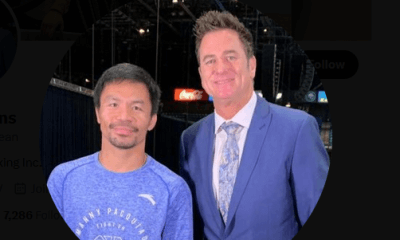
 Featured Articles1 week ago
Featured Articles1 week agoFrom the Boondocks to the Big Time, The Wild Saga of Manny Pacquiao’s Sidekick Sean Gibbons


